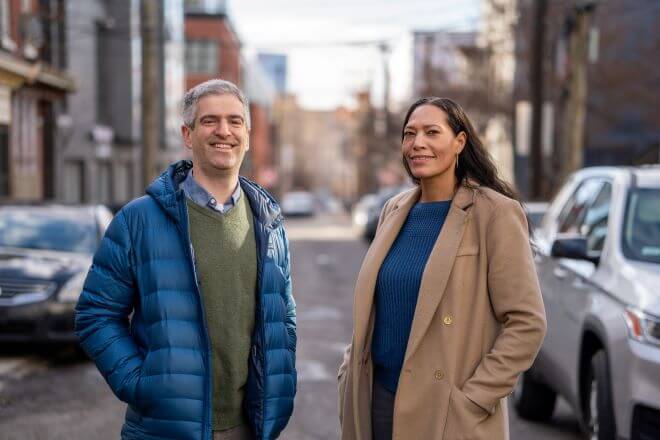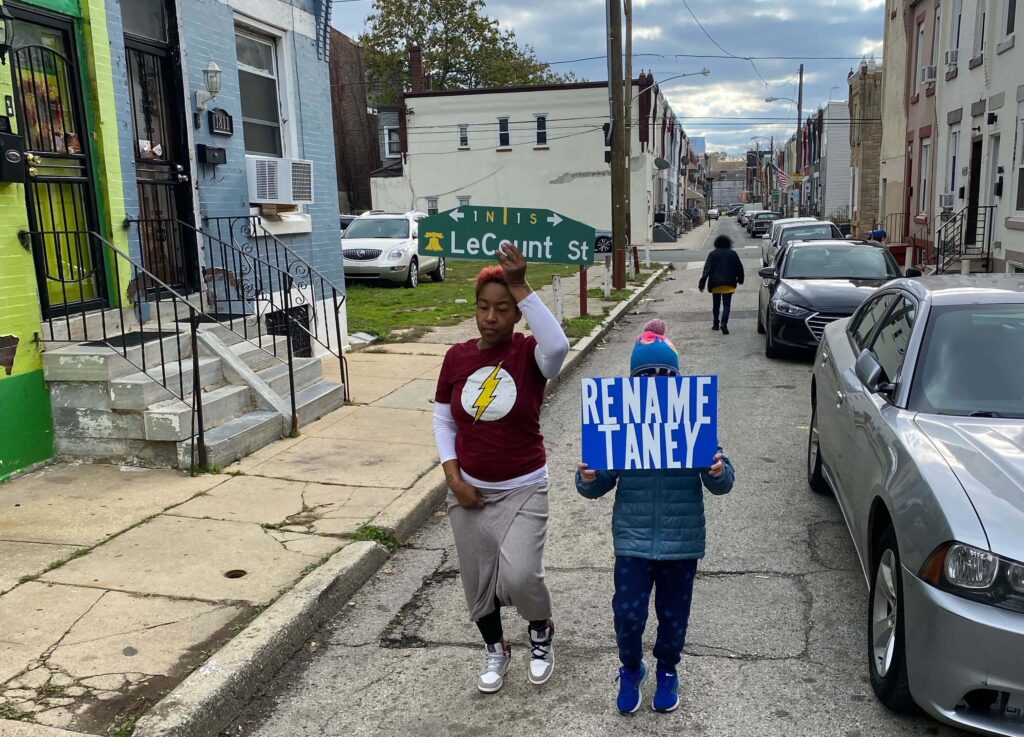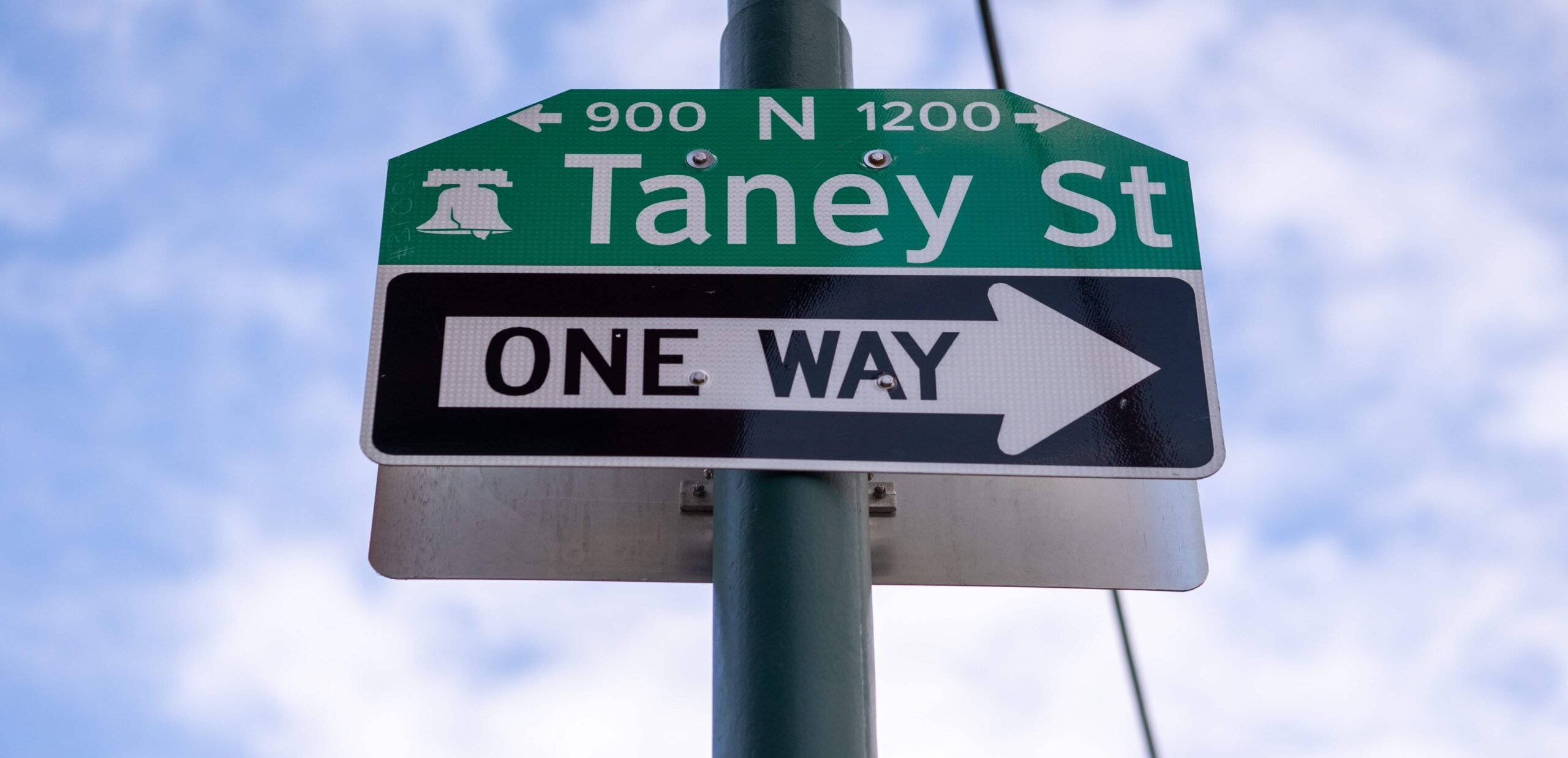How hard, do you think, is it to rename a Philadelphia street? What about renaming a street that’s only 15 blocks? What about renaming a little Philly one-wayer named for Roger B. Taney, the author of the notorious 1857 Dred Scott v. Sanford decision — which deemed African Americans were not U.S. citizens — thereby becoming one of the most harm-inducing Supreme Court Justices in U.S. history?
If you answered, “very hard,” you are correct.
For three years, a group of volunteer residents and neighbors of generally charming Taney Street have been trying to change their blocks’ name. The group has surveyed neighbors online. They’ve written letters. They’ve door-knocked galore, and gotten nearly everyone to join team Rename. They’ve taken time away from work and family and themselves … simply to get something done that most everyone believes should be done.
All that’s needed for the change is City Council’s approval — which is all but guaranteed if the three City Council members whose districts encompass Taney Street give the thumbs-up to a new name. Instead, almost inexplicably, folks on City Council and their representatives have repeatedly described the process of renaming Taney Street as “complex,” “not easy,” “unprecedented” and “a Pandora’s box.”
Do we need to review all the ways monuments, street names, school names, etc., send messages about our values? Wouldn’t changing Taney Street to something non-racist, even pro-equality, and directly Philadelphian be virtually effortless win-win?
Here, yet again, is another example of Philadelphia citizens doing the opposite of a Philly shrug — working together to make their little slice of our city one we can all be proud of — only to be told by Council: You want nice things? You can have ’em. But you have to follow a bunch of rules that we are going to make up along the way to make the process opaque, painful and borderline impossible. Welcome to Philadelphia!
Nobody likes Roger B. Taney
Philadelphians often boast about their city being laid out on an easy-to-navigate grid. But beyond Center City, that grid becomes a total tangle. Streets stop and start again, ending at intersections, parks, and buildings. Some change names. Some go one way, then another.
Taney is one of those streets. You find it now and again between 26th and 27th streets, rarely lasting more than three contiguous blocks, sometimes running North, sometimes, South.
On its Southern end, Taney takes up four blocks in Graduate Hospital and Fitler Square, in the 2nd District, Kenyatta Johnson’s. It resumes at Aspen Street in Fairmount, spanning eight blocks into Brewerytown at Ridge Avenue — the 5th District, Council President Darrell Clarke’s. It later heads out of Strawberry Mansion for 3 (really, 2.5 blocks) in the 4th District, Curtis Jones Jr.’s.
[Editor’s note: Clarke has since retired; in 2024, Jeffrey Young Jr. became the Councilmember for the 4th District.]
To date, no one involved in this project can say for sure how Taney Street got its name. We do know it was named (well, renamed, from Minor Street) in 1858, one year after Dred Scott, back when Chief Justice Taney was a very famous (infamous) American. Famous for, you know, writing the decision that said an African American, even when he’d moved to a free state, was still not free — a ruling that is considered a major trigger for the Civil War.
In Taney’s words: Black Americans, “being of an inferior order, and altogether unfit to associate with the White race … and so far inferior, that they had no rights which the White man was bound to respect … that the negro might justly and lawfully be reduced to slavery for his [own] benefit.”
What’s more, we know for sure Taney did not hang out in Philly. No one has unearthed any record of Roger B. Taney doing a damn thing in the 2-1-5. Naming a street for him in 1858 would be like naming a street, I don’t know, Tom Brady Way … in 2019.
Do we need to review all the ways monuments, street names, school names, etc., send messages about our values? Wouldn’t changing Taney Street to something non-racist, even pro-equality, and directly Philadelphian be virtually effortless win-win?
The folks behind Rename Taney thought so. Wanna know who agreed with them? Taney descendant Joy Taney, that’s who.
Plus, there’s precedent. In 2017, Baltimore and Annapolis — both actually located in the state of his birth and residence — removed their Taney statues. Last year, the House voted to replace the bust of Taney in the U.S. Capitol with that of Thurgood Marshall. In between, the Philadelphia youth athletic league, whose baseball team, with help from Mo’ne Davis and the Anderson Monarchs, almost went all the way to win the 2014 Little League World Series, dropped Taney from their name.
Getting it done. Or not
There is no official City process to change a street name. The only requirements, say Rename Taney co-founder Ben Keys, is that all City Councilmembers whose districts contain the street agree on an ordinance, propose “a one-line bill in City Council,” and “then vote.” This can happen during any of Council’s 32 annual “stated meetings.” The next one is February 2.

The bulk of the front-end work is civic engagement: drumming up support for the change on the part of street residents. The back end of the work falls to the Streets Department, who say they have to communicate with the Commonwealth, the Postal Service, GPS companies and map apps; get the signs made, and install them. The cost per intersection, says Richard Montanez of the Streets Department, is about $1,500. (About two dozen in all.)
Here’s what the Rename Taney group has done since 2020:
-
- Created an online petition during Covid and obtained 3,000 neighbor signatures.
- Received verbal support from Mayor Kenney and all three Councilmembers, who agreed to let Johnson’s office “run point,” on the project, says Keys.
- Set up a poll to find a new name for the street. Out of 600 people, a 32 percent plurality went to Caroline LeCount, often referred to as “Philadelphia’s Rosa Parks” for the work she did to desegregate the city’s streetcars in the 19th century.
- Enlisted residents to write and send letters to their Councilmembers requesting the name change.
After all this, Jones and Johnson were there for renaming Taney. As for Clarke … well, he wanted more proof. On paper this time, like we do in Philly. He asked for petitions signed by hand by the Taney Street residents in his district. How many? He wouldn’t say, even when asked — and re-asked. Here’s an example of an exchange:
TPC: How many signatures does President Clarke need in order to support an ordinance to rename the street?
Clarke representative’s emailed response: “We’re still waiting to see signatures of residents who live on Taney Street in the 5th District. We’ve asked for those resident signatures from the advocates for the renaming, and we still haven’t received any to date. The most impacted residents are those who live on the street in question.”
Ambiguous mission thus assigned, Rename Taney returned to Taney Street and did as they were told, a task they described as “time-intensive,” “challenging,” “extraordinary,” and “unreasonable.”
“Frankly, it’s not something that a City Councilperson has to do when trying to win an election, so they might not appreciate just how challenging it is,” says volunteer Samaya Brown, who lives a block off of N. Taney Street in Clarke’s district.
Not only did they go back: They also went big. Free hot chocolate big. Helen Gym-in-the-street big. Philly Elmo-and-drum corps big. (Although Keys appreciates Gym’s support, he said Philly Elmo was most effective, “It’s a very narrow street. Having the drums echo off the walls was great.”)
Now, Rename Taney says they’ve knocked on every door — some four times. They’ve run into a fair amount of vacant buildings and doors that never got answered. But so far, the group estimates, 95 percent of residents they spoke with were down for the name change.
Even the hesitant ones. Brown met an Asian American resident who had “blacked over the name ‘Taney’ on her door plaque,” she says. When another neighbor questioned the need to change the street name, Brown pointed to the home of the first resident. “At that moment, [the second resident] put it together in her mind, why it needed to be done.”
“We have done the work here,” says Brown. “We have gone above and beyond what a typical civic engagement should be.”
Keys describes the small handful of folks who refused to sign as “longtime residents who view this as somehow affecting their memories of Taney Street and not recognizing the effect the name has on others.” He describes this reaction as either a “knee-jerk reaction to change” or, a “knee-jerk racist response” of “Why do you want to change the name from a White person’s name to a Black person’s name?”
Waiting. And waiting.
At this point, the group seems nearly stymied by the vagueness of Clarke’s demand. For weeks, they’ve been working to figure out if they have all the signatures they need, that all t’s are crossed, etc. They’ve still not received instruction on exactly how much Clarke’s office needs from them.
Nor has Clarke’s office responded to requests for more information. They are, said a spokesperson, “very busy.” They did, however, go on the record in 2021, when Clarke’s Director of Communications Joe Grace told Billy Penn in 2021, “Renaming a city street is a fairly elaborate process.”
Sure. But the elaborate part of the process is behind us. Past street renamings have happened, like Keys says, via one-sentence ordinances. (You can see a list of Philadelphia street name changes since 2000 going to City Council’s online Legislative Information Center, clicking the legislation tab, searching up “changing of the name” and selecting “all years.” There are about 10 of them, all brief.)
A representative for Johnson’s office did say they’d “received objections,” without saying how many, or laying out any fact-based grounds. And Keys says everyone he’s talked to has been fairly unconcerned with any name-change hassle.

Plus, it isn’t much of a hassle anyway. The Postal Service gives residents of renamed streets a 10-year grace period to change their address. The U.S.P.S. also automatically pushes out the change to FedEx, Google, Uber and the like. What’s more — fun facts galore! — a street’s name is the last thing the Postal Service looks for when routing mail. They’d much rather use those four dangling digits after your zip code.
Residents would not have to change the deeds to their homes, as deeds are registered by latitude and longitude. They would need to bring proof of the street’s name change to the DMV the next time they renewed their driver’s license.
For help with matters like this, Rename Taney offered to create a how-to mailer or flier to be distributed among Taney Street residents. They discussed appointing someone from each councilmember’s office to handle issues relating to street name change.
“We have done the work here,” says Brown. “We have gone above and beyond what a typical civic engagement should be.”
Maybe that’s the point. Maybe it’s a case of if the people in charge put up enough obstacles, the people who want change will just drop it. Maybe this is why (again) we Philadelphians can’t have nice things …
“This kind of process definitely deters other efforts to improve our communities,” says Keys … “If Philadelphia is going to be a place that gets things done, it needs to get things like this done.”
![]() RELATED STORIES ABOUT PHILLY CITIZENS TAKING ACTION
RELATED STORIES ABOUT PHILLY CITIZENS TAKING ACTION




